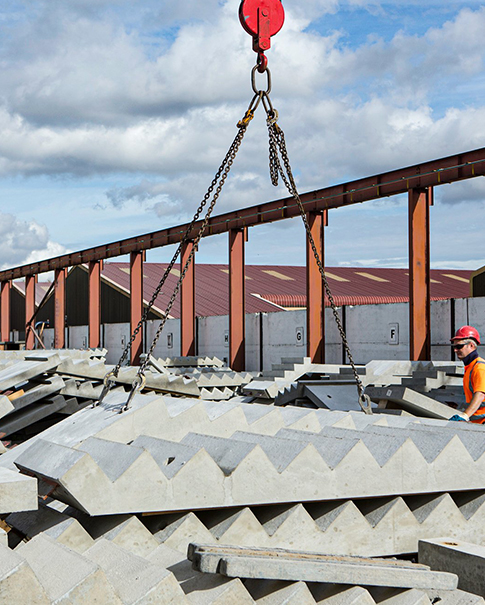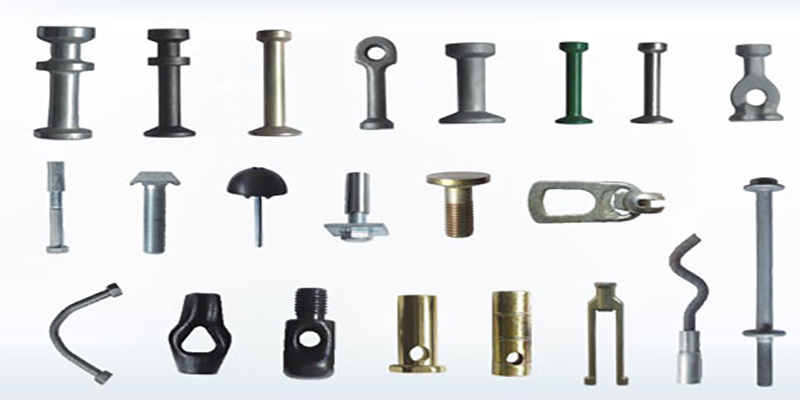-

Envie-nos um e-mail
sale@lscmagnetics.com -

Número de contato
+86 -13559234186

Envie-nos um e-mail
sale@lscmagnetics.com
Número de contato
+86 -13559234186
Uma análise completa do aço usado em âncoras de elevação: Quais são as diferenças entre aço puro, aço galvanizado a quente e aço eletrogalvanizado?
Aug 08, 2025Em uma fábrica de componentes de concreto pré-moldado, um painel de parede pesando várias toneladas é constantemente levantado, girado e posicionado com precisão por um guindaste. Por trás desse movimento aparentemente sem esforço, reside uma decisão crucial de engenharia: o tipo de aço usado para o chumbadoresAço puro, aço galvanizado a quente ou aço eletrogalvanizado — esses metais aparentemente comuns são, na verdade, a "tábua de salvação" que suporta um peso imenso. Escolher o chumbador errado pode causar a queda de um componente, atrasar a construção ou até mesmo levar a um grande incidente de segurança.

O Trio da Armadura de Ferro: Os Segredos Técnicos por Trás do Revestimento
1. Parafusos de ancoragem de aço nu: a espada de dois gumes da força bruta
Chumbadores de aço puro, não tratados e forjados em aço-liga de alta resistência, oferecem vantagens em termos de resistência à tração máxima (tipicamente atingindo 800-1000 MPa) e custo-benefício. No entanto, sua principal desvantagem é a alarmante taxa de corrosão em ambientes úmidos. Dados de laboratório mostram que, após três meses de exposição a umidade superior a 60%, sua superfície apresenta ferrugem vermelha visível e sua resistência à tração diminui em 15%. Portanto, são adequados apenas para instalação temporária em ambientes internos secos ou como fixações temporárias durante concretagens (que são então cobertas).
2. Parafusos de ancoragem de aço galvanizado a quente: um guardião de ambientes de trabalho pesado
O processo de produção pode ser descrito como um "banho de lava derretida para aço": após sete etapas de limpeza (desengorduramento, decapagem e fluxo), os chumbadores são imersos em um banho de zinco fundido a 460 °C, formando uma camada de liga de zinco-ferro de 80 a 100 μm. Esse processo oferece três vantagens principais:
- Proteção anódica de sacrifício: a camada de zinco corrói preferencialmente, protegendo o aço subjacente e oferecendo uma vida útil de 20 a 50 anos.
- Colagem mecânica: O zinco penetra nos microporos da superfície do aço, criando uma adesão 10 vezes mais forte que a galvanoplastia.
- Cobertura total: Até mesmo as folgas das roscas são seladas com a camada de zinco, não deixando pontos cegos.
A desvantagem é uma perda potencial de 5% a 8% na resistência devido ao recozimento em alta temperatura e uma superfície áspera com nódulos de zinco (exigindo juntas especiais para evitar arranhões).
3. Parafusos de ancoragem de aço eletrogalvanizado: guardiões elegantes de ambientes de precisão
Em um banho eletroquímico, uma corrente elétrica impulsiona a deposição de íons de zinco, formando um revestimento semelhante a um espelho com apenas 10-12 μm de espessura. Seus principais valores residem em:
- Deformação térmica zero: O processo em temperatura ambiente mantém a resistência original do aço (particularmente adequado para aços de ultra-alta resistência acima de 1000 MPa).
- Superfície lisa: reduz o desgaste das eslingas e aumenta a vida útil do cabo em 30%.
- Dimensões de precisão: o revestimento uniforme garante que não haja perda de ajuste da rosca.
No entanto, testes de névoa salina mostram que sua resistência à corrosão é apenas um quinto daquela da galvanização a quente em condições semelhantes, e sua vida útil ao ar livre normalmente não excede cinco anos.
Como o revestimento afeta a segurança de elevação?
| Indicadores de desempenho | Parafusos de ancoragem de aço nu | Parafusos de ancoragem galvanizados a quente | Parafusos de ancoragem eletrogalvanizados |
| Resistência à corrosão | Ferrugem após 3 meses de exposição | 20-50 anos (incluindo ambientes marinhos) | <5 anos (ao ar livre) |
| Retenção de força | Diminui 15% anualmente em ambientes úmidos | Perdas por recozimento em alta temperatura: 5-8% | Praticamente nenhum dano |
| Resistência à fadiga por vibração | Diminui rapidamente após a ferrugem | A camada de zinco absorve a energia da vibração, aumentando o desempenho em 30% | Revestimento suscetível ao crescimento de microfissuras |
| Resistência a altas temperaturas | Estável | A camada de zinco amolece em temperaturas acima de 80°C | Estável até 200°C |
| Econômico | Preço mais baixo | Alto custo inicial, baixo custo do ciclo de vida | Custo geral moderado |
Cuidado — o diabo está nos detalhes: quatro armadilhas na aplicação de revestimentos
1. Armadilha de compatibilidade: âncoras galvanizadas a quente podem causar corrosão eletroquímica (profundidade média de corrosão de 0,2 mm por ano) quando em contato com fôrmas de alumínio. Solução: use juntas isolantes de nylon ou troque por um sistema totalmente de aço inoxidável.
2. Ponto cego de atenuação magnética: Resíduos de concreto ou óleo na superfície galvanizada podem reduzir a aderência do suporte magnético em 40%. A limpeza deve ser feita com uma espátula de aço inoxidável (ferramentas de ferro são proibidas para evitar a magnetização).
3. Risco de Operação em Alta Temperatura: Ao utilizar âncoras galvanizadas por imersão a quente perto de um forno de cura a vapor, temperaturas superiores a 80 °C podem causar a desmagnetização da camada de zinco. Um fabricante de PCs no norte da China apresentou falha na âncora devido à cura a vapor no inverno. Esse problema foi resolvido com a troca para modelos resistentes a altas temperaturas com ímãs de neodímio (operando a 150 °C).
4. Identificação de galvanização falsa: revestimentos de zinco galvanizados de baixa qualidade com espessura inferior a 5 μm podem ser detectados com um medidor de espessura magnético (o requisito padrão é ≥ 10 μm).
Portanto, é crucial priorizar os padrões e a conformidade do setor.
As âncoras de elevação galvanizadas a quente e eletrogalvanizadas estão sujeitas a vários padrões e regulamentações do setor para garantir sua segurança e desempenho em operações de elevação.
Por exemplo, na Austrália, as ancoragens de içamento devem estar em conformidade com a norma AS 3850.1:2015, que define requisitos específicos para a fabricação, teste e uso de ancoragens de içamento na construção, garantindo que sejam seguras, confiáveis e atendam às expectativas de qualidade. Esta norma inclui disposições para o uso adequado de aço revestido e não revestido, enfatizando a importância da proteção contra corrosão na integridade estrutural dos sistemas de içamento.
Da mesma forma, nos Estados Unidos, a norma ASTM A123/A123M rege o processo de galvanização por imersão a quente, garantindo que a espessura e a qualidade do revestimento atendam aos requisitos de proteção contra corrosão. A norma ASTM B633, que se aplica à galvanoplastia, incluindo a eletrogalvanização, especifica a espessura, a aderência e o desempenho do revestimento para diversas aplicações. Essas normas fornecem orientações para a seleção do método de proteção contra corrosão apropriado com base na exposição ambiental e nos requisitos de carga mecânica.
Os fabricantes de âncoras de içamento devem aderir a essas normas para garantir que seus componentes atendam às expectativas de segurança e durabilidade, especialmente em ambientes propensos à corrosão. A adesão a essas normas do setor garante que empreiteiros e engenheiros possam confiar no desempenho e na longevidade dos produtos que utilizam, evitando as consequências custosas e perigosas da falha do aço devido à ferrugem.
Por fim, um guia de seleção baseado em cenários: tornando cada chumbador o mais adequado para o trabalho.
🏗️ Preferindo chumbadores galvanizados a quente
- Ambientes altamente corrosivos: edifícios costeiros, fábricas de produtos químicos, zonas de congelamento e degelo (corrosão por agentes de degelo)
- Elevação de cargas pesadas: grandes vigas e colunas pesando >5 toneladas, placas em T duplo (requer um sistema magnético de classe 2100 kg)
- Gerenciamento completo do ciclo de vida: chumbadores de uso geral que exigem reutilização (por exemplo, moldes de linha de montagem)
⚡ Preferir chumbadores eletrogalvanizados
- Componentes de precisão: Lajes de concreto decorativas (nódulos superficiais de zinco não são permitidos)
- Ambientes internos secos: Divisórias internas pré-moldadas, móveis de concreto
- Aplicações de aço de ultra-alta resistência: parafusos de grau 10.9 e superiores (para evitar fragilidade térmica)
⛔ Onde o aço nu é estritamente proibido
- Pontos de suspensão permanentemente expostos: Estruturas suspensas, como esculturas artísticas de concreto
- Ambientes de alta umidade: componentes de porão, instalações de tratamento de água
ETIQUETAS :